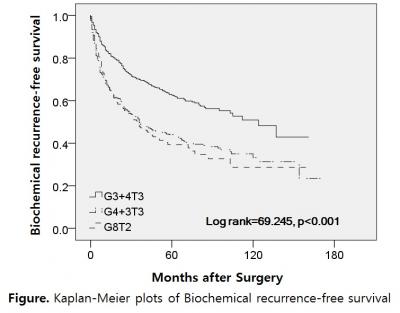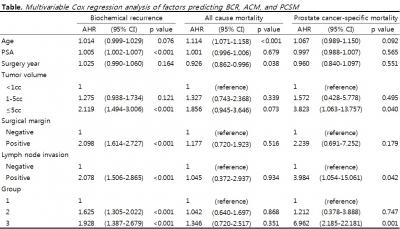|
Cancer - Prostate(구연)
|
MP Session Ⅰ (MP-010)
Geumkang Hall (Avenue 2F)
11월 28일(수) 16:00-17:00
|
|
|
Gleason score versus T stage after radical prostatectomy: which is more important? |
| 연세대학교 의과대학 비뇨기과학 교실, 비뇨의과학 연구소 |
| 허지은, 박지수, 이종수, 김종찬, 장원식, 나군호, 최영득, 홍성준, 함원식 |
Purpose: Adjuvant radiation therapy (RT) is considered in the case with adverse pathologic features without considering radical prostatectomy Gleason score (RP GS). We investigate prognosis according to RP GS and pathologic T (pT) stage and analyze which factors is more important to predict prognosis.
Methods: Of 4,969 men who underwent radical prostatectomy between 1995 and 2015, the cohort was divided into three based on RP GS and pT stage, including group 1-RP GS 7(3+4) and pT3 in 760, group 2-RP GS 7(4+3) and pT3 in 565, and group 3-RP GS 8-10 and pT2 in 260. We compared biochemical recurrence (BCR), all-cause mortality, and prostate cancer-specific mortality (PCSM) risk among the groups using Cox regression.
Results: At a median follow-up of 58 months (IQR 37-85), 721 men experienced BCR and 84 died (22 due to PCa). BCR-free survival in group 3 was worse than in other groups (group 1: p<0.001, group 2: p=0.638). For overall survival, there is no difference among the groups. PCa-specific survival in group 3 was significant lower than group 1 and 2 (p=0.001, p=0.007, respectively). In Cox regression model, most of variables including group were independently associated with BCR. Group was the only prognostic factor for PCSM. Group 2 showed HR of 1.212 (p=0.747) and group 3 led to HR of 6.962 (p=0.001) for group 1.
Conclusion: RP GS 8-10 and pT2 PCa showed higher BCR and PCSM rates than RP GS 7 and pT3 PCa. These findings suggest that high RP GS should be considered in decision of adjuvant treatment and adjuvant RT can be considered in men with RP GS 8-10 and pT2. |
  |
|
keywords : Gleason score, Mortality, Prostate cancer |
|

